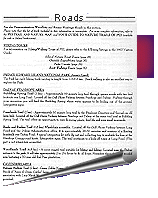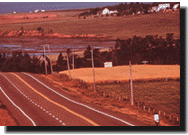
 In Prince Edward Island, like everywhere else
in the world, roads play a key role in economic
development, establishing networks for settlement and
commerce in general. From the early days until today, and
again into the future, roads connect farmers, markets,
and consumers, merchants, businesses, and clients, clergy
and congregations, and doctors and patients.
Well-maintained and clearly marked roads are also vital
to the tourism industry so important to the Island’s
economy.
In Prince Edward Island, like everywhere else
in the world, roads play a key role in economic
development, establishing networks for settlement and
commerce in general. From the early days until today, and
again into the future, roads connect farmers, markets,
and consumers, merchants, businesses, and clients, clergy
and congregations, and doctors and patients.
Well-maintained and clearly marked roads are also vital
to the tourism industry so important to the Island’s
economy. The first inland roads on Prince Edward Island were routes established by the Mi’kmaq, travelling from the south shore to the north shore. Usually short portages from rivers or bays, many of these paths later became roads during European settlement. In the early pioneer days, when Island settlements consisted of homesteads along the shore, most communication occurred by sailing along the coast or canoeing upriver before walking on land. However, poor weather conditions would pose obstacles and, in winter, travel through snow-filled forests became virtually impossible.
The first road on the Island was built in 1731, by Jean Pierre de Roma, who cleared inland paths linking French settlements in Eastern Kings—from Brudenell Point to Sturgeon Bay, Cardigan, Souris, St. Peters, and Port Lajoie. However, these roads grew over after the British sacked the colony at Brudenell. Other early Island roads travelled along the south shore of the Hillsborough River and from the West River across to Beach Point on Malpeque Bay. Eventually, in the late 1700s and early 1800s, a web of roads connecting Island communities slowly began to emerge.
 Early road building
was relatively easy on the Island due to our sandy soil,
its drying capacity and the relative absence of rock. At
this time, clearing trees and stumps was the most
challenging component of construction. Today, road
construction and maintenance is very costly, due largely
to our lack of quality aggregate (the mix of gravel,
rock, and sand needed for road building). Furthermore, at
more than 3,800 kilometres, Prince Edward Island has more
paved highway per capita than any province in Canada.
This adds to the relatively high costs of maintaining
this vital infrastructure. Road and bridge design,
construction, and maintenance on Prince Edward Island are
also subject to guidelines designed to protect the
environment. Measures to prevent erosion, silt
accumulation, and poor drainage are strictly enforced.
Early road building
was relatively easy on the Island due to our sandy soil,
its drying capacity and the relative absence of rock. At
this time, clearing trees and stumps was the most
challenging component of construction. Today, road
construction and maintenance is very costly, due largely
to our lack of quality aggregate (the mix of gravel,
rock, and sand needed for road building). Furthermore, at
more than 3,800 kilometres, Prince Edward Island has more
paved highway per capita than any province in Canada.
This adds to the relatively high costs of maintaining
this vital infrastructure. Road and bridge design,
construction, and maintenance on Prince Edward Island are
also subject to guidelines designed to protect the
environment. Measures to prevent erosion, silt
accumulation, and poor drainage are strictly enforced. While the environment, snow removal, sanding, circulation, and speeding are contemporary highway safety concerns, road safety on the Island was the subject of a slightly different type of concern at the turn of the century. In 1908, the Province of Prince Edward Island banned the use of automobiles on Island roads. Horses, still the primary mode of transport for Prince Edward Islanders, were terrified by the noise and smell of automobiles. Several accidents resulted from
 horse
and automobiles meeting on a narrow Island roadway. These
accidents were so feared that many farmers would stay
home from market to avoid meeting an auto along the road.
Men would forbid their wives and children to venture onto
the roads unaccompanied and many families even stayed
home from church, fearing the result of an encounter
between horse and automobile. Many Islanders also
objected to this expensive luxury item, available only to
a small minority of wealthy folk, which so impeded
movement of the public on Island roads.
horse
and automobiles meeting on a narrow Island roadway. These
accidents were so feared that many farmers would stay
home from market to avoid meeting an auto along the road.
Men would forbid their wives and children to venture onto
the roads unaccompanied and many families even stayed
home from church, fearing the result of an encounter
between horse and automobile. Many Islanders also
objected to this expensive luxury item, available only to
a small minority of wealthy folk, which so impeded
movement of the public on Island roads. In 1913, the New Automobile Act allowed cars to travel Island roads on Mondays, Wednesdays and Thursdays only. This kept four auto-free days during the week—Tuesdays and Fridays for going to market, Saturdays for shopping, and Sundays for Church services. Five years later, in 1918, automobiles were permitted on Island roads every day of the week. Since then, Islanders have grown to depend on motor vehicles and safe roads and highways to maintain the patterns of communication between communities that are vital to the contemporary Island Way of Life.
Ferry Service | Confederation Bridge | Confederation Trail | Air Travel